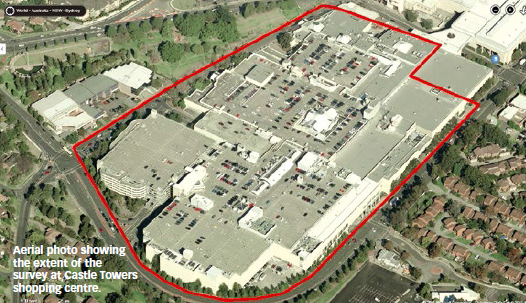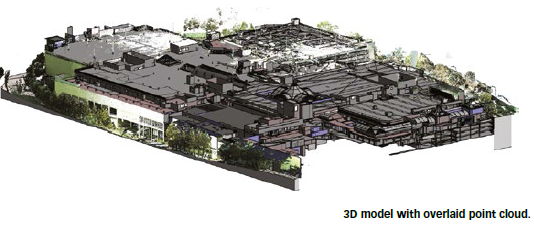When an international retail group approached the Australian surveying firm, Project Surveyors, about creating a survey-accurate architectural and structural Revit model for the country’s second largest shopping centre, the firm was excited to participate.
When the deadline was set for only 90 days later, Project Surveyors knew while future centre customers may shop till they dropped, the firm’s seven qualified laser scanning surveyors would be doing the same with 3D laser scanning.The Sydney shopping centre is currently undergoing redevelopment, and the client needed a fully-parametric Revit Building Information Modelling (BIM) model for architects, engineers and facility managers to accurately plan the work needed. Covering a space of 375,000 square metres with vari-ous dimensional obstacles, such as cascading floors, topographic level changes and add-on buildings of diverse sizes, Project Surveyors faced one of its most complex jobs in its 43-year history.
“The enormity and complicated aspects to the building meant that our surveyors had to be meticulous when documenting scan positions and on field notes to assist in the registration of scans,” said Andy Jackson, Project Surveyors’ BIM Spatial manager. “With our Leica Geosystems instruments and soft-ware, we could ensure this.”

Scanning, modelling with confidence
Project Surveyors used a variety of Leica Geosystems solutions to capture, model and analyse the data. Starting with the Leica ScanScations C10 and P20, the surveyors were able to capture minute details. The Leica ScanStation C10 was used for the external facades and inside for large structures, such as the parking garages, due to its long-range capability. Inside, the Leica ScanStation P20 was used for its quality of producing fast reliable data at low resolution.
“The fast scanning time of the P20 helped us improve site workflow, increasing the number of scans per day fourfold,” said Jackson.
For survey control, Project Surveyors used the Leica TS15 and Leica MultiStation MS50. The Multi-Station was also used to scan windows for simpler capturing. Establishing a survey control network around the perimeter of the site and throughout the shopping centre at each level, these instruments ensured millimetre precision for aligning scans of the retrofitting construction. Laser scan targets were coordinated within the control network to maintain the accuracy of the overall point clouds.
A total of 3,700 scans from 55 days on site resulted from the project. The point clouds from these scans were cleaned and registered using Leica Cyclone 9.0. The entire process only took 20 days due to the addition of the auto-alignment registration within the software. Compared to point cloud-to-point cloud visual alignment, which would take around two minutes each to visually find common points, auto-alignment only takes 30 seconds to one minute.
“The time does not sound like much for a few scans, but when we’re talking about thousands of scans, this becomes a significant amount of time saved,” said Jackson. “With these savings, we were able to increase our productivity by at least 50 percent.”
The firm also used Leica TruView to provide the architects with the point cloud data so they could overlay in the model and have extra information, such as dimensions they needed to extract for accu-rate and realistic planning.
“Leica Truview images were a deliverable for the client, but they also helped the modeller to have a complete understanding of what they are modelling over,” said Jackson.
Autodesk Revit 2014 was used to model architectural elements while Autodesk Revit Mechanical, Electrical, Piping (MEP) was used to create pipes, plant, ducts and other services to create a partial MEP model of the loading docks. As the size and detail of this project would have taken one modeller 120 days to complete, Project Surveyors worked with a team of modellers in collaboration on one central model across a wired and large-data network.
Using the export option in Leica Cyclone 9.0, the surveyors exported the point clouds either separately as binary ptg files or unified as pts files. Autodesk Recap was then used to convert the files into Autodesk-compatible rcs files, which could then be inserted into Revit and modelled over. Using Leica Cloudwork for Revit, Jackson added that the exportation and conversion steps of the workflow would be eliminated, providing modellers with point cloud conversion tools as well as a single master data source rather than multiple files and versions of files to deal with.
“Using this laser scanning technology, we have won similar large projects, such as one in Sydney where we’re working with the same consultants who used this model as an example to the project owner of what they required as survey information,” said Scott Deveridge, Project Surveyors director. “Referrals to provide a similar service on another challenging project is the best feedback we can get.”
Lessons learned from HxGN LIVE
With attending HxGN LIVE 2014 in Las Vegas only a few months before the start of the project, Pro-ject Surveyors found the shopping centre project a valuable opportunity to put some of the lessons it learned at the international conference and exhibition to practice. Using these new ideas, the firm real-ised an approximate time savings of 75 percent.
Using scan-to-scan registration and auto alignment, the firm decreased its dependence on targets for every scan. The surveyors also used a lower resolution, kept the scanner operating between setups, and created a wheeled-transport tripod to relocate the scanner faster.
“Whereas before we were only able to collect about 16 scans per day, using what we learned from HxGN LIVE, we can now collect anywhere between 60 to 80 scans per day,” said Jackson. “We are also registering about 30 scans per hour, twice as much as before. This translates into significant efficiency gains, and therefore cost savings, for us.”
Returning to HxGN LIVE 2015 in Las Vegas, the project took top honors in the annual Leica Geosys-tems High-Definition Surveying (HDS) Plan Contest. A panel of 11 qualified judges evaluated 24 en-tries based on the completeness and usefulness of the plans, the creative use of point clouds and models, and overall appearance. Project Surveyors took first place with the project in the Build-ings/Heritage category.
“Our team has worked hard, and we are always looking for innovative ways to improve our business,” said Jackson. “Winning this award confirms our commitment to the profession and our dedication to the clients.”
A prime example
Another aspect of the Sydney shopping centre project is the innovative use of HDS in BIM. Through the use of a variety of HDS techniques in the field and in the office, Project Surveyors was able to organise and collaborate building information across an accessible platform.
“Using laser scanning in BIM helps us to have a complete understanding of what’s already there, what needs to be done, and how well the building process took place,” said Jackson. “Using laser scanning in BIM allows us to provide value-added deliverables to our clients.”
This project is an ideal demonstration of making the real digital world. As HDS captures the most current and accurate situation, professionals can then implement that data into software programs, such as Leica Cyclone or Autodesk Recap, to produce the realistic workable models. Exact adaptions can then be made so that when work is carried out on site, intelligent information is clear and error-free.
“The technology of HDS provides the tools and workflows needed to accurately and definitively cap-ture digital assets in minutes.” said Faheem Khan, vice president, business development manager for Leica Geosystems HDS. “Being able to capture, manage and deliver information and knowledge to all stakeholders underpins our strategy to provide the fastest, cleanest and most reliable hardware as well as a software portfolio that scales for all project sizes, disciplines and users.”



